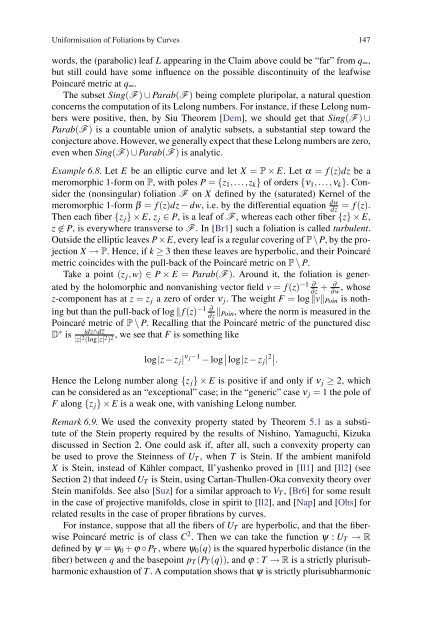Discrete Holomorphic Local Dynamical Systems
Discrete Holomorphic Local Dynamical Systems
Discrete Holomorphic Local Dynamical Systems
Create successful ePaper yourself
Turn your PDF publications into a flip-book with our unique Google optimized e-Paper software.
Uniformisation of Foliations by Curves 147<br />
words, the (parabolic) leaf L appearing in the Claim above could be “far” from q∞,<br />
but still could have some influence on the possible discontinuity of the leafwise<br />
Poincarémetricatq∞.<br />
The subset Sing(F ) ∪ Parab(F ) being complete pluripolar, a natural question<br />
concerns the computation of its Lelong numbers. For instance, if these Lelong numbers<br />
were positive, then, by Siu Theorem [Dem], we should get that Sing(F ) ∪<br />
Parab(F ) is a countable union of analytic subsets, a substantial step toward the<br />
conjecture above. However, we generally expect that these Lelong numbers are zero,<br />
even when Sing(F ) ∪ Parab(F ) is analytic.<br />
Example 6.8. Let E be an elliptic curve and let X = P × E. Letα = f (z)dz be a<br />
meromorphic 1-form on P, with poles P = {z1,...,zk} of orders {ν1,...,νk}. Consider<br />
the (nonsingular) foliation F on X defined by the (saturated) Kernel of the<br />
meromorphic 1-form β = f (z)dz− dw, i.e. by the differential equation dw<br />
dz = f (z).<br />
Then each fiber {z j}×E, z j ∈ P, is a leaf of F , whereas each other fiber {z}×E,<br />
z �∈ P, is everywhere transverse to F .In[Br1] such a foliation is called turbulent.<br />
Outside the elliptic leaves P×E, every leaf is a regular covering of P\P, by the projection<br />
X → P. Hence, if k ≥ 3 then these leaves are hyperbolic, and their Poincaré<br />
metric coincides with the pull-back of the PoincarémetriconP \ P.<br />
Take a point (z j,w) ∈ P × E = Parab(F ). Around it, the foliation is generated<br />
by the holomorphic and nonvanishing vector field v = f (z) −1 ∂ ∂<br />
∂z + ∂w , whose<br />
z-component has at z = z j a zero of order ν j. The weight F = log�v�Poin is nothing<br />
but than the pull-back of log� f (z) −1 ∂<br />
∂z �Poin, where the norm is measured in the<br />
Poincaré metricofP \ P. Recalling that the Poincaré metric of the punctured disc<br />
D∗ idz∧d ¯z is<br />
|z| 2 (log|z| 2 ) 2 , we see that F is something like<br />
log|z − z j| ν j−1 − log � �log|z − z j| 2� �.<br />
Hence the Lelong number along {z j}×E is positive if and only if ν j ≥ 2, which<br />
can be considered as an “exceptional” case; in the “generic” case ν j = 1 the pole of<br />
F along {z j}×E is a weak one, with vanishing Lelong number.<br />
Remark 6.9. We used the convexity property stated by Theorem 5.1 as a substitute<br />
of the Stein property required by the results of Nishino, Yamaguchi, Kizuka<br />
discussed in Section 2. One could ask if, after all, such a convexity property can<br />
be used to prove the Steinness of UT ,whenT is Stein. If the ambient manifold<br />
X is Stein, instead of Kähler compact, Il’yashenko proved in [Il1] and[Il2] (see<br />
Section 2) that indeed UT is Stein, using Cartan-Thullen-Oka convexity theory over<br />
Stein manifolds. See also [Suz] for a similar approach to VT ,[Br6] for some result<br />
in the case of projective manifolds, close in spirit to [Il2], and [Nap] and[Ohs] for<br />
related results in the case of proper fibrations by curves.<br />
For instance, suppose that all the fibers of UT are hyperbolic, and that the fiberwise<br />
Poincaré metricisofclassC 2 . Then we can take the function ψ : UT → R<br />
defined by ψ = ψ0 + ϕ ◦ PT ,whereψ0(q) is the squared hyperbolic distance (in the<br />
fiber) between q and the basepoint pT (PT (q)), andϕ : T → R is a strictly plurisubharmonic<br />
exhaustion of T . A computation shows that ψ is strictly plurisubharmonic



